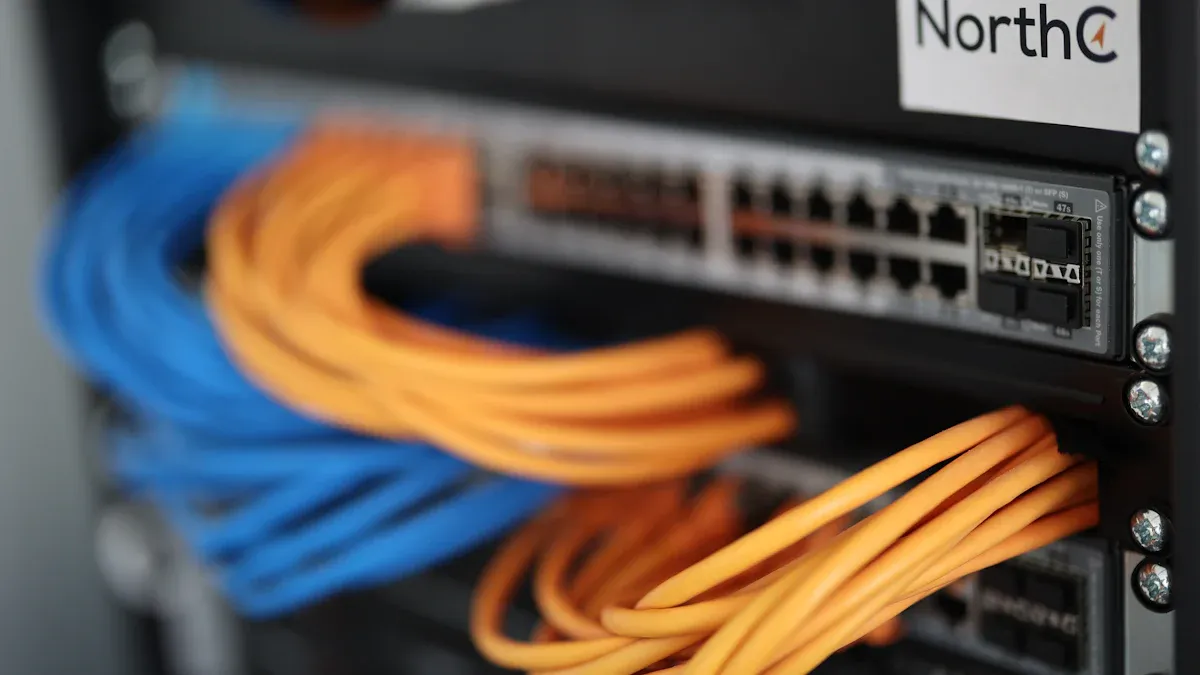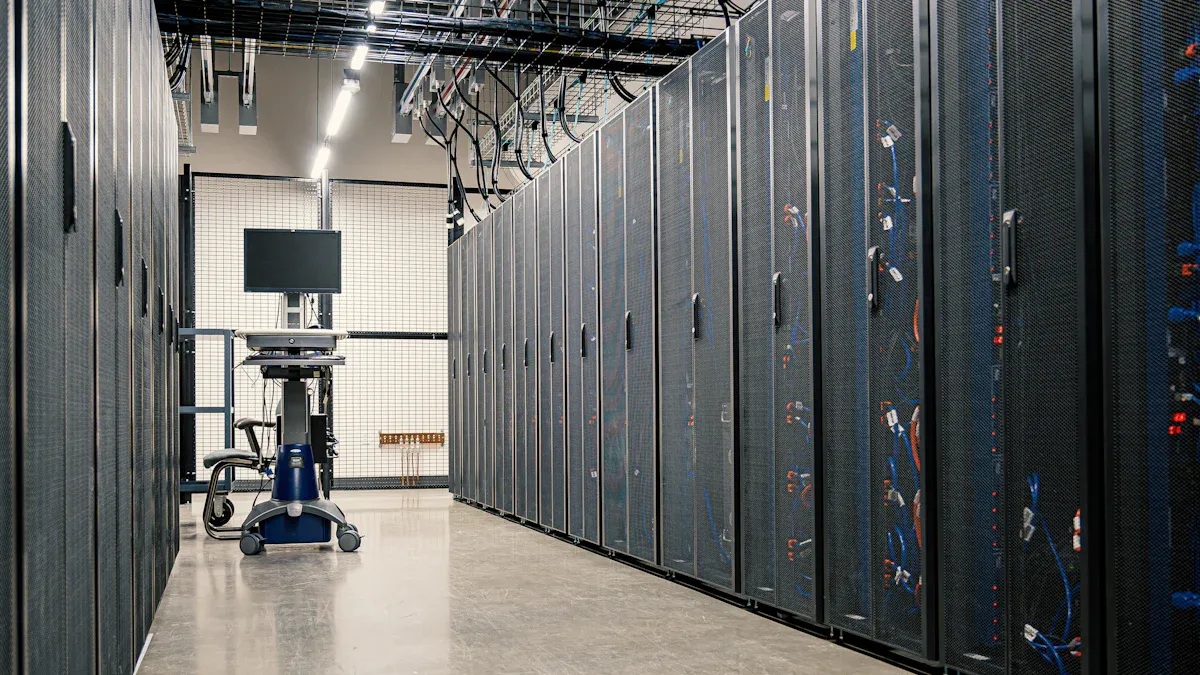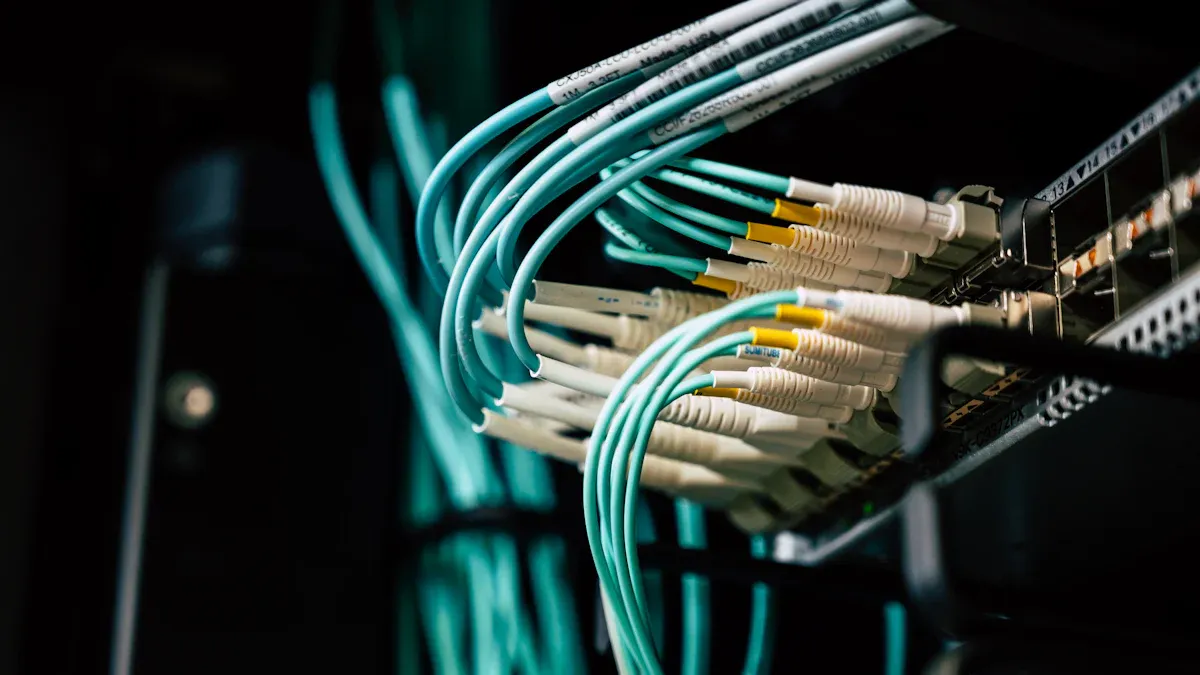© Copyright – 2010-2023 : All Rights Reserved. Sitemap
Power Distribution Unit PDU, rack mount PDU, PDU data center, Smart PDu, intelligent PDU
Power Distribution Unit PDU, rack mount PDU, PDU data center, Smart PDu, intelligent PDU
DTI-CX 2025 Digital Transformation Indonesia Conference, DATE:6-7 AUG.2025, Booth No.: C21

You can improve your data center by choosing a 1u switched pdu. This device offers space efficiency, remote power management, and better monitoring and control. Many large data centers now use intelligent PDUs because they want more uptime and smarter power management. In fact, the adoption rate of these solutions in hyperscale data centers grows by over 18% each year, showing a strong move toward advanced power solutions. However, you should also consider higher costs, setup complexity, and the risk of a single point of failure when making your decision.

You can maximize your data center’s available space by choosing a 1u switched pdu. This device fits into a single rack unit, which means you have more room for servers and other equipment. The compact design helps you organize your rack and improves airflow, which reduces the risk of overheating. High-density data centers benefit from this space-saving feature because you can install more devices without crowding the rack.
Tip: Better cable management is possible when you use a 1u switched pdu. You can install it alongside servers, which keeps cables neat and reduces clutter.
Here is a quick look at how space efficiency improves your data center:
| Feature | Benefit |
|---|---|
| Compact Design | Optimizes space in server racks |
| Occupies 1U of Space | Maximizes available room for other equipment |
| Enhances Organization | Improves airflow and reduces overheating |
You also reduce operational downtime by 15% compared to metered PDUs. This means your data center runs smoother and you spend less time fixing problems.
You can control power to each device in your data center without being on-site. A 1u switched pdu lets you turn outlets on or off from anywhere. This remote power management feature helps you prevent overloads and restart locked-up equipment quickly. You save time and keep your data center running efficiently.
| Feature | Impact on Operational Efficiency |
|---|---|
| Real-time Monitoring | Identifies power-hungry devices and optimizes energy use. |
| Individual Outlet Control | Prevents overloads and recycles power to locked-up equipment. |
| Power Sequencing | Protects sensitive equipment during startup by preventing inrush. |
| Security Measures | Ensures only authorized personnel can make changes, enhancing safety. |
| Network Management | Saves time and improves uptime through remote configuration. |
You can also set alarms to alert you when conditions go out of range. This helps you respond quickly and protect your equipment.
You gain advanced monitoring capabilities with a 1u switched pdu. You can track power usage at each outlet and see real-time monitoring data. This helps you manage energy use and prevent overloads. You can switch outlets remotely, which lets you recover from unresponsive equipment fast.
Enhanced monitoring features give you a detailed view of power consumption. You can make better decisions and keep your data center reliable. Monitoring helps you spot problems before they cause downtime. You keep your distribution system safe and your data center running smoothly.
You may notice that a 1U switched pdu costs more than basic power strips or metered PDUs. Several factors drive up the price. These devices use advanced designs to handle high power demands, especially in high-density data centers. Manufacturers certify them to operate at high temperatures, sometimes up to 60°C (140°F). This level of engineering ensures reliability but adds to the cost.
You also pay more for extra features like real-time monitoring and outlet-level control. Premium brands offer advanced monitoring capabilities, which help you track power use and spot problems early. The price can vary a lot depending on the brand and the features you choose. Reliability and redundancy matter in a data center, so you often invest more to avoid downtime.
Note: Investing in a high-quality PDU can save you money in the long run by reducing downtime and protecting your equipment.
When you install a switched PDU, you face more complexity than with a basic or metered unit. You must set up network connections, configure security settings, and manage user access. Switched PDUs give you remote control over each outlet, which means you can power cycle equipment from anywhere. This feature helps you reduce downtime and operational costs, but it also requires careful setup.
You need to understand how to use features like staged power-up sequencing. This function lets you restore power in a controlled way after an outage, which protects your equipment from surges. You can also lock unused outlets to improve security and ensure proper power distribution. Managing power on a per-outlet basis helps you cut energy waste, but it adds another layer of management.
Tip: Training your team on PDU management tools can help you avoid mistakes and get the most out of your monitoring capabilities.
A single PDU can become a point of failure in your data center. If one unit fails, it can disrupt power distribution to all connected devices. This risk can lead to outages, equipment damage, and even financial losses. The table below shows some of the main risks:
| Risk Type | Description |
|---|---|
| Vulnerability to power outages | Single power sources can cause outages from grid instability, overvoltage spikes, or cooling failures. |
| Financial and reputational risks | Power outages may lead to data breaches, customer dissatisfaction, and loss of trust. |
| Economic impact | The U.S. economy loses $18 billion to $33 billion each year due to power outages. |
You can reduce this risk by using dual power PDU systems. These systems connect to two separate power sources. If one source fails, the other takes over right away. Automatic Transfer Switches (ATS) help by monitoring both inputs and switching between them without manual help. This setup keeps your data center running and protects your equipment from unexpected outages.
Remember: Redundancy in your power distribution design is key to keeping your data center reliable and safe.

You need to look at your rack space before you choose a 1u switched pdu. In a data center, every inch of rack space counts. Some PDUs mount vertically along the side of the rack. These vertical units use the “zero U” space, so you do not lose any horizontal rack units. This setup leaves more room for servers and storage devices. If you have a high-density environment, saving rack space helps you fit more equipment and improves airflow for better distribution of cool air.
Tip: Always check if your rack supports both horizontal and vertical mounting options for your PDU.
Remote management is a key feature in modern data centers. You want to control power and monitor devices without being on-site. A good PDU lets you turn outlets on or off, reboot equipment, and check power flow from anywhere. Many models offer a web interface for easy access. Some support SNMP, which helps you connect the PDU to your network management system. You can also group outlets to reboot several devices at once. This level of control improves your power distribution and helps you respond quickly to problems.
| Feature | Description |
|---|---|
| Remote Power Control | Turn on, off, or reboot devices from anywhere. |
| Monitoring Capabilities | See current flow at each outlet for better distribution. |
| Integrated Power Management | Use a web interface for easy access and control. |
| SNMP Capability | Connect to network management systems for remote commands. |
| Outlet Grouping | Reboot multiple devices at once for efficient power management. |
Monitoring plays a big role in keeping your data center running smoothly. You should look for a PDU that offers real-time monitoring of power usage. This helps you track energy efficiency and avoid overloads. Some PDUs include sensors for temperature and humidity, which protect your equipment. Alerts warn you if power levels go outside safe limits. You can also get detailed data at both the PDU and outlet level. Secure locking features prevent accidental unplugging, which keeps your distribution reliable.
| Monitoring Feature | Description |
|---|---|
| Real-time power usage monitoring | Track power use as it happens for efficient operations. |
| Environmental condition monitoring | Use sensors to watch temperature and humidity. |
| Alerts for unusual power states | Get notified right away if something goes wrong. |
| Metering at PDU and outlet levels | See detailed power data for each outlet and the whole unit. |
| Precise kWh energy usage data | Measure energy use with high accuracy to improve energy efficiency. |
| Secure locking enhancement | Prevent accidental disconnections for safer distribution. |
You want to get the most value for your money when you choose a pdu for your data center. The price of rack and cabinet pdus can vary, but you should look at more than just the initial cost. Think about how much you will spend over time. Efficient rack pdus help you save on energy and reduce downtime. You also spend less on maintenance when you choose a reliable unit.
Here is a table that shows how costs and value balance out:
| Cost Type | Description |
|---|---|
| Acquisition Costs | The price you pay to buy the pdu. |
| Operational Costs | Money spent on maintenance and energy use. Efficient pdus lower these costs. |
| Downtime Costs | Losses from equipment failures. Reliable pdus help you avoid these problems. |
| End-of-Life Costs | Expenses for replacing or disposing of pdus. Durable units last longer and cost less to replace. |
You should compare features and long-term savings. For example, NBYOSUN offers remote power control, advanced monitoring, and high customization. Other budget brands may not provide these benefits. The right choice helps you improve energy efficiency and keep your distribution system running smoothly.
Reliability matters in every data center. You need to make sure your distribution system keeps working, even if something fails. Redundancy means you have backup systems ready. You can use two rack pdus in each rack to protect your equipment. Some pdus have dual power inputs and automatic transfer switches. These features switch to a backup source if the main one fails.
Here are important reliability and redundancy features:
You can build a strong system by following these steps:
Different redundancy models exist. N+1 adds one backup unit, N+2 adds two, and 2N doubles the whole system for full fault tolerance. These designs help you keep your data center safe and avoid downtime.
You have many choices when you look for a 1U switched pdu. NBYOSUN stands out with its aluminum alloy housing, wide outlet spacing, and customizable options. You get remote monitoring, power sequencing, and circuit breakers for better safety. NBYOSUN’s pdus also support real-time monitoring and integrate with environmental sensors. This helps you track power capacity and keep your distribution system efficient.
Here is a comparison of NBYOSUN and other brands:
| Aspect | NBYOSUN | Other Brands (Vertiv, Eaton, Raritan, Tripp Lite) |
|---|---|---|
| Design & Durability | Aluminum alloy, customizable, wide spacing | Modular, scalable, advanced monitoring |
| Advanced Features | Remote monitoring, power sequencing, circuit breakers | Intelligent monitoring, thermal management |
| Performance | 15% energy savings, 20% uptime boost | High reliability, strong long-term performance |
| Reliability | Dual inputs, failover mechanisms | Fault tolerance, continuous power delivery |
| Cost | Competitive pricing, customization | Higher initial costs, cost-effective options |
NBYOSUN’s YS1504-1P-L620R-MPIP model offers 4 NEMA L6-20R outlets, 50A max current, and supports SNMP and HTTP for remote management. It meets ISO9001, CE, UL, and RoHS standards. Other brands like APC, Eaton, and Vertiv also provide strong options, but NBYOSUN focuses on customization and advanced monitoring. You can choose the best pdu for your data center by comparing these features and certifications.
You gain space efficiency, remote control, and advanced monitoring when you choose a 1U switched PDU for your data center. You should weigh these benefits against higher costs and added complexity. For best results, follow these steps:
NBYOSUN offers reliable solutions for environments that need efficient monitoring and control.
“1U” means the PDU takes up one unit of rack space. You save room for other equipment. Most server racks use this standard size.
Yes, you can manage power outlets using a web browser or network tools. You turn devices on or off without being in the data center.
You get remote control, real-time monitoring, and better safety. A switched PDU helps you fix problems faster and keep your data center running smoothly.
You use two PDUs for each rack. If one fails, the other keeps your equipment powered. This setup protects your data and prevents downtime.
Tip: Always check your PDU’s status and set alerts for quick action.
A Professional And Leading Manufacturer
For OEM
& ODM Power Distribution Unit (PDU)
You Can Trust
CONTACT
Ningbo YOSUN Electric Technology Co., LTD
Leading Professional Manufacturer in PDU Power Solutions
Contact Info.